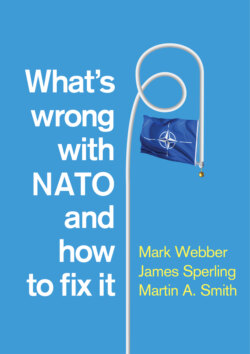Читать книгу What's Wrong with NATO and How to Fix it - Mark Webber - Страница 11
NATO is not in terminal decline
ОглавлениеDeclinist views have characterized much commentary and scholarship on NATO. But time after time, such views have proven wrong. During the Cold War, the Suez Crisis of 1956, French withdrawal from NATO’s integrated military commands in the 1960s and differences in the early 1980s between the Reagan administration and some European governments over how to deal with the Soviets were all seen as evidence of internal corrosion. However, as Wallace Thies has convincingly argued, the Alliance’s ‘self-healing tendencies’ of democratic membership, internal democratic decision-making and institutional complexity ensured the accommodation of its members’ interests, and with it ongoing resolve in facing down the Soviet bloc.15
Declinist positions resurfaced at the Cold War’s end only to be confounded by NATO’s repurposing in the 1990s. By 1995, one analyst was able to write that ‘European security was once again dominated by the NATO alliance and US leadership, perhaps to a greater extent than even in the last years of the Cold War.’16 The prompt for that verdict was the Alliance’s decisive aerial intervention in Bosnia. Operation Deliberate Force, launched in August 1995, served as the catalyst for the Dayton Peace Accords, which finally brought a semblance of political stability to the troubled Balkan region. It also marked NATO’s entry into peacekeeping (60,000 NATO personnel would go on to be deployed to Bosnia, the largest military deployment in Europe since World War II). NATO undertook a further air operation four years later. Operation Allied Force pushed the Serb leader Slobodan Milošević to a peace deal over Kosovo and paved the way for the entry of the KFOR (Kosovo Force) peacekeeping mission to the troubled province. A smaller-scale NATO intervention in neighbouring Macedonia in 2001 also had a decisive effect in restoring political order. NATO’s attentions then moved to the far-off theatre of Afghanistan. In 2003, it assumed formal responsibility for the International Security Assistance Force (ISAF). ISAF would prove NATO’s most complex and demanding mission of the post-Cold War period, entailing both nation-building and gruelling counter-insurgency warfare. In 2015, a new non-combat mission, Operation Resolute Support, was initiated. These missions (along with a further aerial campaign, Operation Unified Protector, in Libya in 2011, and the return to collective defence in the face of Russia’s actions against Ukraine after 2014) have not been without their problems, as was noted above. But even if one accepts the criticism that NATO operations have lacked an overarching sense of strategic purpose, taken together they are nonetheless a measure of allied staying power.17
An organization whose purpose is to protect the security of its members will necessarily have to confront its enemies and face down threats. Dealing with crisis – whether in the Balkans, Afghanistan, Libya or on NATO’s eastern flank facing Russia – is simply part and parcel of what NATO does. To infer from such a state of affairs that NATO itself is ‘in crisis’ is a mistaken leap of logic.18 Time and again, the Alliance has proven its naysayers wrong as it has responded, rather than surrendered, to some of the tough security challenges of the late twentieth and early twenty-first centuries.
